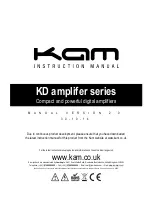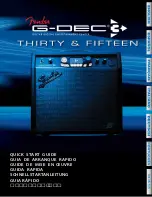
7
6. Technical Data: pocket tools
dual mix
Technical data
Inputs
Switchable microphone or line input
Combo socket, XLR and ¼“ jack (6.35 mm)
line mode (jack input)
Unbalanced high impedance input for
instrument pick-ups and line-level sources
Gain adjustment range: +3…+20 dB
Min. input voltage: 100 mV (–20 dBV)
Max. input voltage: 3 V (+10 dBV)
Input impedance: 2.2 M
|| 60 pF
Signal-to-noise ratio, A-weighted
Min. gain: 108 dB
Max. gain: 98 dB
Frequency response: 20 Hz…20 kHz /
1 dB
THD + N (1 kHz): < 0.3%
mic mode (XLR input)
Balanced microphone input
1 = ground, 2 = positive (+), 3 = negative (–)
Gain adjustment range: +4…+40 dB
Min. input voltage: 10 mV (–40 dBV)
Max. input voltage: 3 V (+10 dBV)
Input impedance: 2.1 k
Unbalanced:1.1 k
Signal-to-noise ratio, A-weighted
Min. gain: 108 dB
Max. gain: 93 dB
Frequency response: 20 Hz…20 kHz /
1 dB
THD + N (1 kHz): < 0.1%
Phantom power: 24 V, R = 1.2 k
per
terminal, switchable for each channel,
total current max. 10 mA per channel,
short circuit protected
Warning: External equipment may be
damaged by inappropriate use of
phantom power. In case of doubt keep the
24 V phantom power switch off (not
pushed).
channels 1
and 2
Clip indicator
Red LED
Headroom: 8 dB
aux in
Auxiliary stereo input (mono-mixed), e.g. for
CD player
Cinch (RCA) sockets (left / right) and 3.5 mm
stereo jack socket.
Level control
Min. input voltage: 2 x 250 mV (–14 dBV)
Max. input voltage: 2 x 10 V (+20 dBV)
Input impedance: 10 k
Outputs
line out
Unbalanced line output after master
Mono jack, ¼” (6.35 mm)
Nominal output voltage: 1 V (0 dBV)
Max. output voltage: 9 V (+19 dBV)
Output impedance: 47
Min. load impedance: 2 k
Residual noise (master fully anticlockwise):
A-weighted: 1
μ
V (–120 dBV)
headphones Headphones output
Stereo jack, ¼” (6.35 mm)
Output power, 1 kHz, THD = 1%:
Typ. 2 x 40 mW / 32
Residual noise (master fully anticlockwise):
A-weighted: 3.3
μ
V (–110 dBV)
Warning: Suitable for headphones with
stereo jack only. Do not connect any mono
jacks.
DI-out
Balanced XLR output
1 = ground, 2 = positive (+), 3 = negative (–)
Level control
Nominal output voltage (differential),
adjustment range:
41…410 mV (–28…–8 dBV)
Output impedance:
47
each terminal to ground
Min. load impedance (differential): 1 k
Residual noise (both channels in line mode),
A-weighted: 3.3
μ
V (–110 dBV)
Tone controls
low
12 dB at 100 Hz (shelf type)
channels 1
and 2
high
13 dB at 10 kHz (shelf type)
Effects
Built-in
effect
Digital effect processor with 4 presets
1 = Reverb with short predelay
2 = Reverb with long predelay
3 = Repeating delay
4 = Chorus
Footswitch connector
footswitch
Connector for a dual footswitch
Stereo jack, ¼” (6.35 mm)
Tip = footswitch for muting channel 1
Ring = footswitch for muting channel 2
Sleeve = ground (common)
Function: Switch ON = channel muted
Power
Supply
voltage
24 V=, 0.5 A
Use only supplied mains adapter.
Mains
adapter
Mains voltage: 100-240 V~
Power consumption when used with Dual
Mix: max. 10 W
General
Metal
housing
Aluminium
Finish
Anodized black
Dimensions
65 mm (2.56“) high
105 mm (4.13“) wide
135 mm (5.31“) deep
Weight
480 g (1.06 lbs)
Definitions and conditions
Input and output voltages are RMS values for a sine signal
and 1 kHz unless stated otherwise.
Tone controls in neutral position unless stated otherwise.
Min. input voltage: Input voltage for nominal output
voltage at line out with gain and master fully clockwise.
Max. input voltage: Permissible input voltage that does not
cause distortion more than the rated THD + N (assuming
suitable control settings).
Signal-to-noise ratio (SNR): Ratio of nominal output voltage
to noise voltage at line out, at specified gain setting,
master fully clockwise, input shorted, 20 Hz…20 kHz.
Note: The SNR found at line out may be less than the SNRs
specified for the channels because both channels
contribute to the output noise.
Residual noise: Noise voltage at an output when all gain
and level settings are minimal.
THD + N: Total harmonic dist noise for nominal
output voltage at line out
Specifications and appearance subject to change without
notice.
TD20111123
Содержание pocket tools dual mix
Страница 1: ...1 pocket tools dual mix user manual ...
Страница 9: ...notes 9 ...
Страница 10: ...10 notes ...
Страница 11: ...11 notes ...
Страница 12: ...www aer amps com DualMix 2011_11_GB ...






























